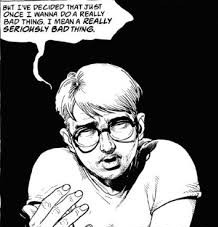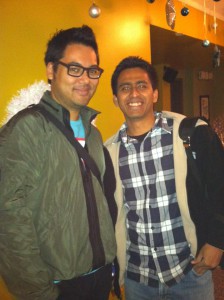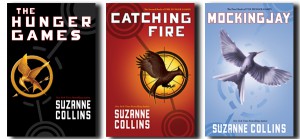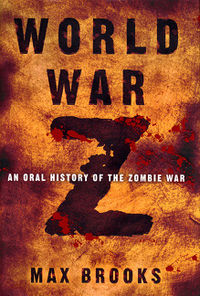Christmas Eve last year promised to be a sedate affair. I was recuperating from my (nearly) month-long trip, and all I had on my mind was an evening of peace and quiet, alone with three cats in the house. But Bryan Lee O’Malley, he of Scott Pilgrim fame, tweeted about the movie Battle Royale being screened at the Silent Movie theater. That’s a quaint-looking location on Fairfax I remembered passing by and wondering about quite a few times on the way to Hollywood. Battle Royale being one of the few movies that fall in the viewed-5-times-and-above category for me, I was tempted. Despite having owned and seen multiple DVD versions – The Regular version, the Extended Director’s Cut and the Uncut Edition had all appeared in National Market, I had never seen it in a theater. Further investigation revealed that the film had never seen a theatrical release in the US, thanks to the Columbine incident occurring the same year it released in Japan. So this screening would be the first official screening, based on a high definition conversion of the upcoming Blu-ray release by Anchor Bay. All of the above reasons were enough for me to drop my plans of lying back on my couch with a purring cat on my belly and sipping on metaphorical pennyroyal tea. Off I went.
Needless to say, I had an amazing time, and even met O’Malley at the popcorn stand.
The last time I saw Battle Royale was in 2007. None of my love for the movie had waned in five years, but there was a strange outsider-level objectivity that crept in this time. I never realized, for example, how annoyingly earnest the two lead characters were. Both Shuya and Noriko were too sugary, too good to be true. Maybe it was the Hunger Games experience from a few weeks ago that had supplanted my blind devotion to this movie. Or maybe it was the manga I read a few years ago, which made the characters of Mitsuko and Kiriyama so much more engaging than the one-note killing machines they turn out in the movie. I also found myself chuckling along at some of the over-the-top acting – Nobu’s death, the dramatic gestures some of the students make when they exit the classroom at the beginning, Kitano’s star-tinted turn.
I like re-watching movies with different people. Primarily because of the fresh perspective such a viewing brings. The odd little reactions you happen to notice in others at scenes that you reacted to differently. Or because you are focusing on a something other than the primary plot and pay more attention to the details that passed you by the first time. Maybe a snatch of a soundtrack, an in-joke that you did not get the first time. Something that resonates from an article you read about the movie, maybe.
But real life has been catching up. I did not watch too many films the past couple of months, barring the occasional Laemmle marathon and the quickies at the Rave theaters next door to my office. I cannot seem to sit down before the laptop/TV and watch anything at a stretch. Terabytes of old movie dumps have been “liberated” on random whims, because I know I will never get around to watching them.
Yesterday, I went and watched Lagaan – this time with a group of people of which I knew only one. We made a proper movie evening out of it, with bhelpuri, samosas and popcorn aplenty and a generous smattering of enthusiasm in the audience, most of whom had seen it already. It was my 20th viewing of Lagaan, my obsession with that movie having lasted through multiple cities, different levels of Aamir-Khan-reaction and Rahman-adulation, and a constant loathing of cricket. (And yes, I started keeping count after the 8th viewing) I enjoyed it thoroughly. It still makes me laugh at the right story and character moments. Paul Blackthorne as Captain Russell and Chris England as Yardley fill me with fanboy glee, and I am tempted to reread England’s book as soon as I can (it’s called From Balham to Bollywood, and it was a great read the first time).
There is a peculiar happiness also to noticing the same somewhat-bloopers – like Bhuvan saying Radha’s husband is Anay, instead of the correct Ayan, or the presence of two cricketers named Smith and Wesson in the English XI, especially the fact that Elizabeth dances with just the two of them at the ball. Thanks to the DVD being an American release, the scenes with the British characters alone had English dialogues, instead of Amitabh Bachchan’s baritone explaining the proceedings. We did skip over the ‘O Paalanhare’ song, which to me is the nadir of the movie, an unnecessary face-palm of a sequence rendered even more painful by Lata Mangeshkar’s voice. [ref]Earlier musings on Lagaan here and here. [/ref]
I spent a total of 4 hours on the bus, both ways. But totally worth it.
A two-week-long retrospective of Studio Ghibli films begins this Thursday. They include fifteen classic Miyazaki and Takahata films being screened at the Egyptian theater in Hollywood and the Aero theater in Santa Monica. I have made up my mind to attend every one of them. Sure, I own all the DVDs, and have seen the films multiple times, but the joy of the rewatch compells me. Besides, I’ve heard enough shit from pal Jussi about how he saw them screened in theaters in Helsinki and it’s high time I get back at him.
The only ones not being screened are EarthSea, Ponyo, Arrietty and Grave of the Fireflies. I can understand the absence of the fourth film, but not the first three. Oh well.



